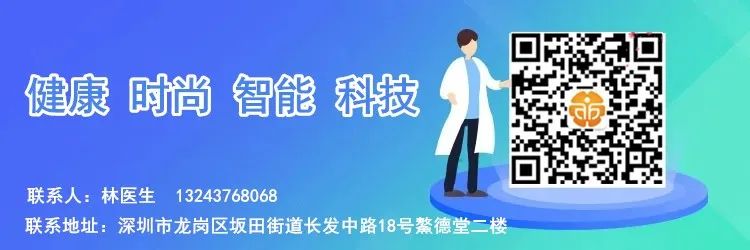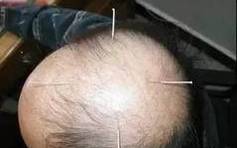
 Aode Traditional Chinese Medicine
Aode Traditional Chinese Medicine
 Health Headlines
Health Headlines
 Consult a Doctor
Consult a Doctor
 Traditional Chinese Medicine Mall
Traditional Chinese Medicine Mall
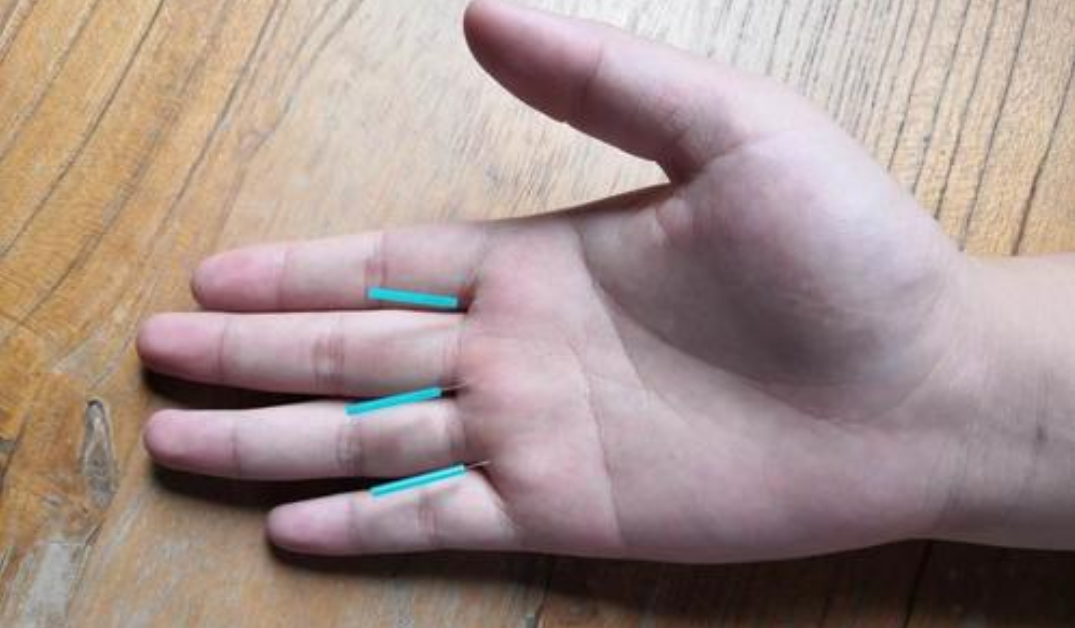
Guide:
Three Needles has two layers of meaning. Initially, it was used to treat a patient with allergic rhinitis, and after three treatments, the patient was cured. When asked what this therapy was, I spontaneously replied that it was the “Nasal Three Needles”. Later, through literature research and clinical summary, I developed a method of treating one disease with three acupuncture points. At that time, a reporter came to interview, and upon observation, they found that three needles were indeed used, which led to coverage. Since then, the “Three Needles” became famous worldwide.
Four Spirit Needles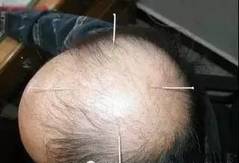 Baihui (百会) point is located 1.5 cun to the front, back, left, and right.Indications:Intellectual disability, dementia, headache, dizziness.Intellectual Three Needles
Baihui (百会) point is located 1.5 cun to the front, back, left, and right.Indications:Intellectual disability, dementia, headache, dizziness.Intellectual Three Needles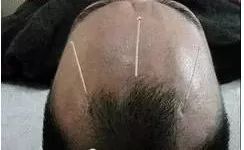 Shenting (神庭) point is the first needle, and the left and right Shen (本神) points are the second and third needles. Shenting is located 0.5 cun directly above the hairline at the center of the forehead. The Shen points are located at the intersection of the inner two-thirds and outer one-third of the line connecting Shenting and Head Wei (头维) points, 0.5 cun above the hairline.Indications:Intellectual disability, mental disorders.Language Three Needlesare located at the first needle at the tip of the thumb between the first and second phalanges, with the second and third needles located 1 cun to the left and right.Indications:Speech disorders, unclear pronunciation, mutism.Drooling, swallowing difficulties.Temporal Three Needles
Shenting (神庭) point is the first needle, and the left and right Shen (本神) points are the second and third needles. Shenting is located 0.5 cun directly above the hairline at the center of the forehead. The Shen points are located at the intersection of the inner two-thirds and outer one-third of the line connecting Shenting and Head Wei (头维) points, 0.5 cun above the hairline.Indications:Intellectual disability, mental disorders.Language Three Needlesare located at the first needle at the tip of the thumb between the first and second phalanges, with the second and third needles located 1 cun to the left and right.Indications:Speech disorders, unclear pronunciation, mutism.Drooling, swallowing difficulties.Temporal Three Needles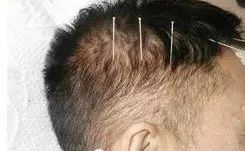 Located 2 cun above the ear apex for the first needle, with the second and third needles placed 1 cun to the front and back at the same level.Indications:Post-stroke sequelae, hemiplegia due to head trauma, cerebral arteriosclerosis, tinnitus, deafness, migraine, Parkinson’s disease, brain atrophy, senile dementia.Calming Spirit Needleis located 0.5 cun above the Yintang (印堂) point for the first needle, 0.5 cun above the left Yangbai (阳白) point for the second needle, and 0.5 cun above the right Yangbai for the third needle.Indications:Inattention, strabismus, frontal headache, nystagmus, dizziness, decreased vision.Needling Technique:Insert 0.5-0.8 cun subcutaneously, applying pressure with a cotton ball at the needle site to prevent bleeding.Dizziness Pain Needle
Located 2 cun above the ear apex for the first needle, with the second and third needles placed 1 cun to the front and back at the same level.Indications:Post-stroke sequelae, hemiplegia due to head trauma, cerebral arteriosclerosis, tinnitus, deafness, migraine, Parkinson’s disease, brain atrophy, senile dementia.Calming Spirit Needleis located 0.5 cun above the Yintang (印堂) point for the first needle, 0.5 cun above the left Yangbai (阳白) point for the second needle, and 0.5 cun above the right Yangbai for the third needle.Indications:Inattention, strabismus, frontal headache, nystagmus, dizziness, decreased vision.Needling Technique:Insert 0.5-0.8 cun subcutaneously, applying pressure with a cotton ball at the needle site to prevent bleeding.Dizziness Pain Needle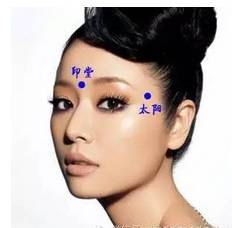 Includes Four Spirit Needles + Yintang and Taiyang (太阳) points.Indications:Dizziness, headache, vertex pain, migraine, frontal pain.Needling Technique:Insert 0.5 to 0.8 cun, being cautious of hard tissue beneath the needle.Facial Muscle Needle
Includes Four Spirit Needles + Yintang and Taiyang (太阳) points.Indications:Dizziness, headache, vertex pain, migraine, frontal pain.Needling Technique:Insert 0.5 to 0.8 cun, being cautious of hard tissue beneath the needle.Facial Muscle Needle 1. Eyelid spasm: Sihai (四白), lower eyelid, Ah Shi (阿是) points.2. Oral muscle spasm: Dica (地仓), Heliang (禾髎), Yingxiang (迎香) points.Needling Technique:Sihai is inserted straight or obliquely 0.5-0.8 cun; Ah Shi point on the lower eyelid is inserted horizontally 0.5 cun; Dica and Qiaoche (颊车) are inserted horizontally 0.5-0.8 cun; Heliang is inserted vertically 0.8 cun. After insertion, use electroacupuncture with continuous wave at a slightly dense frequency. The intensity should be sufficient to cause muscle spasms without pain, leaving the needle for 30-40 minutes.When using electroacupuncture, it is necessary to increase the intensity after 5-10 minutes, as the patient will adapt to the current and it may become ineffective.Fork Three Needles
1. Eyelid spasm: Sihai (四白), lower eyelid, Ah Shi (阿是) points.2. Oral muscle spasm: Dica (地仓), Heliang (禾髎), Yingxiang (迎香) points.Needling Technique:Sihai is inserted straight or obliquely 0.5-0.8 cun; Ah Shi point on the lower eyelid is inserted horizontally 0.5 cun; Dica and Qiaoche (颊车) are inserted horizontally 0.5-0.8 cun; Heliang is inserted vertically 0.8 cun. After insertion, use electroacupuncture with continuous wave at a slightly dense frequency. The intensity should be sufficient to cause muscle spasms without pain, leaving the needle for 30-40 minutes.When using electroacupuncture, it is necessary to increase the intensity after 5-10 minutes, as the patient will adapt to the current and it may become ineffective.Fork Three Needles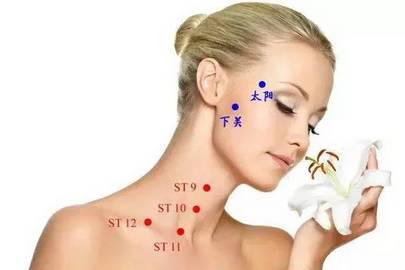 Includes Taiyang, Xiaguan (下关), and Ah Shi points.Needling Technique:Each point is inserted straight 0.5-0.8 cun deep. Electroacupuncture with continuous wave can be added, leaving the needle for 30-40 minutes.Facial Paralysis Needle
Includes Taiyang, Xiaguan (下关), and Ah Shi points.Needling Technique:Each point is inserted straight 0.5-0.8 cun deep. Electroacupuncture with continuous wave can be added, leaving the needle for 30-40 minutes.Facial Paralysis Needle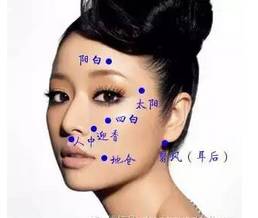 1. Frontal paralysis: Yangbai, Taiyang, Sihai points.2. Oral facial paralysis: Yifeng (翳风), Yingxiang, Dica penetrating to Qiaoche and Renzhong (人中) points.Indications: Facial nerve paralysis, stroke with facial asymmetry.Needling Technique:Yifeng is inserted straight 0.8-1 cun towards the center of the depression behind the ear. Renzhong is inserted obliquely upwards 0.5 cun deep. Other points are needled according to their respective techniques, twisting the needle every 5-10 minutes, leaving the needle for 30-40 minutes.Protruding Three Needles
1. Frontal paralysis: Yangbai, Taiyang, Sihai points.2. Oral facial paralysis: Yifeng (翳风), Yingxiang, Dica penetrating to Qiaoche and Renzhong (人中) points.Indications: Facial nerve paralysis, stroke with facial asymmetry.Needling Technique:Yifeng is inserted straight 0.8-1 cun towards the center of the depression behind the ear. Renzhong is inserted obliquely upwards 0.5 cun deep. Other points are needled according to their respective techniques, twisting the needle every 5-10 minutes, leaving the needle for 30-40 minutes.Protruding Three Needles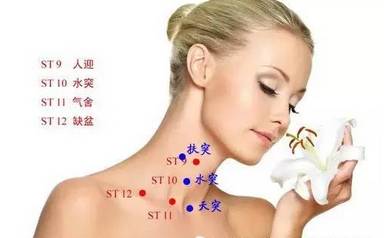 Shuitu (水突), Futu (扶突), Tiantu (天突) points.Indications:Thyroid enlargement, thyroid cyst.Needling Technique:Shuitu is inserted obliquely towards the trachea 0.5-0.7 cun. Futu is inserted similarly; Tiantu is first inserted 0.3 cun, then the needle handle is raised and inserted obliquely towards the sternum for another 0.3 cun. After needling, do not lift the needle, only twist or scrape the needle, leaving it for 30 minutes.Eye Three Needles
Shuitu (水突), Futu (扶突), Tiantu (天突) points.Indications:Thyroid enlargement, thyroid cyst.Needling Technique:Shuitu is inserted obliquely towards the trachea 0.5-0.7 cun. Futu is inserted similarly; Tiantu is first inserted 0.3 cun, then the needle handle is raised and inserted obliquely towards the sternum for another 0.3 cun. After needling, do not lift the needle, only twist or scrape the needle, leaving it for 30 minutes.Eye Three Needles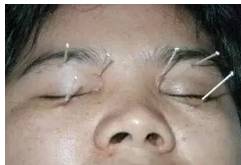 Eye I is located 1 cun above the Qingming (晴明) point. Eye II is directly below the pupil, between the lower orbital margin and the eyeball. Eye III is directly above the pupil, between the upper orbital margin and the eyeball.Indications:Optic nerve atrophy, retinitis, macular degeneration, amblyopia, and other internal eye diseases.Needling Technique:For all three eye needles, instruct the patient to close their eyes. The practitioner should gently stabilize the eyeball with the left hand while holding the needle with the right hand, slowly twisting and inserting the needle. After insertion, do not twist or lift the needle; instead, lightly scrape the needle handle with the thumbnail. For Eye I, gently push the eyeball outward and insert the needle vertically 1-1.2 cun. For Eye II, gently push the eyeball upward and insert the needle straight 1-1.2 cun, close to the lower orbital margin. For Eye III, gently push the eyeball downward and insert the needle straight 1-1.2 cun, initially at a slight upward angle, then at a backward angle.Nasal Three Needles
Eye I is located 1 cun above the Qingming (晴明) point. Eye II is directly below the pupil, between the lower orbital margin and the eyeball. Eye III is directly above the pupil, between the upper orbital margin and the eyeball.Indications:Optic nerve atrophy, retinitis, macular degeneration, amblyopia, and other internal eye diseases.Needling Technique:For all three eye needles, instruct the patient to close their eyes. The practitioner should gently stabilize the eyeball with the left hand while holding the needle with the right hand, slowly twisting and inserting the needle. After insertion, do not twist or lift the needle; instead, lightly scrape the needle handle with the thumbnail. For Eye I, gently push the eyeball outward and insert the needle vertically 1-1.2 cun. For Eye II, gently push the eyeball upward and insert the needle straight 1-1.2 cun, close to the lower orbital margin. For Eye III, gently push the eyeball downward and insert the needle straight 1-1.2 cun, initially at a slight upward angle, then at a backward angle.Nasal Three Needles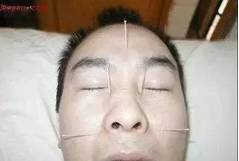 Yingxiang (迎香), Bistong (鼻通, upper Yingxiang), Yintang or Cuanzhu (攒竹) points.Indications:Allergic rhinitis, acute rhinitis, sinusitis, epistaxis, olfactory disorders.Needling Technique:Yingxiang is inserted horizontally 5-8 fen towards the nasal wing; Bistong is inserted horizontally 5 fen deep; Cuanzhu and Yintang are inserted horizontally 3-5 fen.Ear Three Needles
Yingxiang (迎香), Bistong (鼻通, upper Yingxiang), Yintang or Cuanzhu (攒竹) points.Indications:Allergic rhinitis, acute rhinitis, sinusitis, epistaxis, olfactory disorders.Needling Technique:Yingxiang is inserted horizontally 5-8 fen towards the nasal wing; Bistong is inserted horizontally 5 fen deep; Cuanzhu and Yintang are inserted horizontally 3-5 fen.Ear Three Needles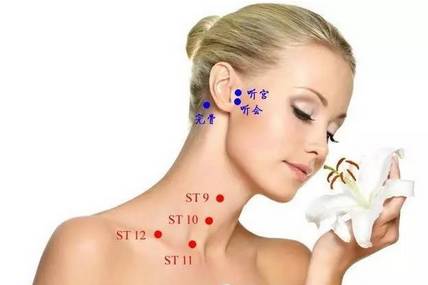 Tinggong (听宫), Tinghui (听会), and Wanggu (完骨) points.Indications:Deafness, tinnitus.Needling Technique:Tinggong and Tinghui are needled straight 1-1.5 cun deep with the mouth open; Wanggu is needled straight 1-1.5 cun deep towards the front and upward. After needling, do not lift the needle; instead, use the thumb to scrape the needle handle or lightly twist it.Hand Three Needles
Tinggong (听宫), Tinghui (听会), and Wanggu (完骨) points.Indications:Deafness, tinnitus.Needling Technique:Tinggong and Tinghui are needled straight 1-1.5 cun deep with the mouth open; Wanggu is needled straight 1-1.5 cun deep towards the front and upward. After needling, do not lift the needle; instead, use the thumb to scrape the needle handle or lightly twist it.Hand Three Needles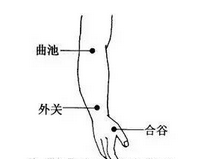 Hegu (合谷), Quchi (曲池), and Waiguan (外关) points.Indications:Upper limb paralysis, numbness, pain, sensory disturbances.Needling Technique:Hegu and Waiguan are needled straight 0.8-1.2 cun deep; Quchi is needled straight 1-1.2 cun deep.Foot Three NeedlesZusanli (足三里), Sanyinjiao (三阴交), and Taichong (太冲) points.Indications:Lower limb sensory or motor disturbances, lower limb paralysis, pain.Needling Technique:Zusanli and Sanyinjiao are needled straight 1-1.5 cun deep; Taichong is needled straight 5-8 fen deep.Hand Intelligence Needle
Hegu (合谷), Quchi (曲池), and Waiguan (外关) points.Indications:Upper limb paralysis, numbness, pain, sensory disturbances.Needling Technique:Hegu and Waiguan are needled straight 0.8-1.2 cun deep; Quchi is needled straight 1-1.2 cun deep.Foot Three NeedlesZusanli (足三里), Sanyinjiao (三阴交), and Taichong (太冲) points.Indications:Lower limb sensory or motor disturbances, lower limb paralysis, pain.Needling Technique:Zusanli and Sanyinjiao are needled straight 1-1.5 cun deep; Taichong is needled straight 5-8 fen deep.Hand Intelligence Needle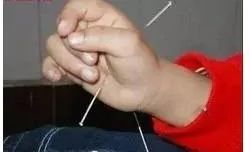 Neiguan (内关), Shenmen (神门), and Laogong (劳宫) points.Indications:Intellectual disability in children, attention deficit hyperactivity disorder, epilepsy, insomnia.Needling Technique:All three points are needled straight 0.5-0.8 cun deep.Foot Intelligence NeedleYongquan (涌泉) point is the first needle, the midpoint of the line connecting the toe joints to the posterior edge of the heel is the second needle (Qianzhong), and the third needle is located 1 cun inward from the second needle (Qianzhong Nei).Indications:Autism in intellectually disabled children, low activity, mutism.Needling Technique:All are needled straight: 0.5-0.8 cun deep.Shoulder Three Needles
Neiguan (内关), Shenmen (神门), and Laogong (劳宫) points.Indications:Intellectual disability in children, attention deficit hyperactivity disorder, epilepsy, insomnia.Needling Technique:All three points are needled straight 0.5-0.8 cun deep.Foot Intelligence NeedleYongquan (涌泉) point is the first needle, the midpoint of the line connecting the toe joints to the posterior edge of the heel is the second needle (Qianzhong), and the third needle is located 1 cun inward from the second needle (Qianzhong Nei).Indications:Autism in intellectually disabled children, low activity, mutism.Needling Technique:All are needled straight: 0.5-0.8 cun deep.Shoulder Three Needles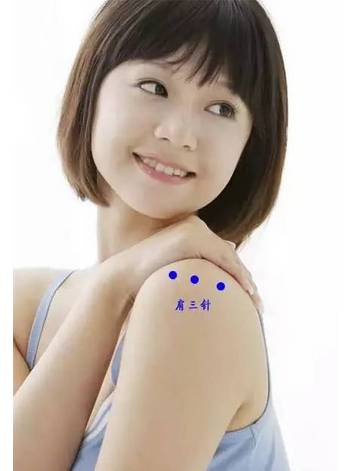 The Jianyu (肩髃) point is the first needle, 2 cun forward at the same level is the second needle, and 2 cun backward at the same level is the third needle.Indications:Shoulder periarthritis, shoulder joint inflammation, upper limb paralysis, inability to raise the shoulder.Needling Technique:The needle tip should be at a 90° angle to the point, inserted straight 0.8-1 cun deep. Be careful not to insert too deeply to avoid injuring the thoracic cavity.Knee Three Needles
The Jianyu (肩髃) point is the first needle, 2 cun forward at the same level is the second needle, and 2 cun backward at the same level is the third needle.Indications:Shoulder periarthritis, shoulder joint inflammation, upper limb paralysis, inability to raise the shoulder.Needling Technique:The needle tip should be at a 90° angle to the point, inserted straight 0.8-1 cun deep. Be careful not to insert too deeply to avoid injuring the thoracic cavity.Knee Three Needles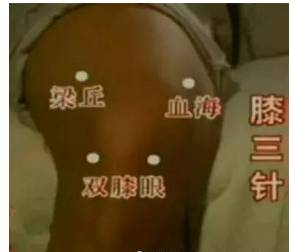 Xiyang (膝眼), Liangqiu (梁丘), and Xuehai (血海) points.Indications:Knee joint swelling, pain, or weakness, knee osteophytes.Needling Technique:Insert straight 0.8-1.2 cun. Electroacupuncture with continuous wave, infrared, and cupping therapy can be added.Lumbar Three Needles
Xiyang (膝眼), Liangqiu (梁丘), and Xuehai (血海) points.Indications:Knee joint swelling, pain, or weakness, knee osteophytes.Needling Technique:Insert straight 0.8-1.2 cun. Electroacupuncture with continuous wave, infrared, and cupping therapy can be added.Lumbar Three Needles Shenshu (肾俞), Dachangshu (大肠俞), and Weizhong (委中) points.Indications:Low back pain, lumbar hyperplasia, lumbar muscle strain, sexual dysfunction, nocturnal emissions, impotence, menstrual irregularities.Needling Technique:All are needled straight 1.2-1.5 cun deep. (Same as knee three needles)Neck Three Needles
Shenshu (肾俞), Dachangshu (大肠俞), and Weizhong (委中) points.Indications:Low back pain, lumbar hyperplasia, lumbar muscle strain, sexual dysfunction, nocturnal emissions, impotence, menstrual irregularities.Needling Technique:All are needled straight 1.2-1.5 cun deep. (Same as knee three needles)Neck Three Needles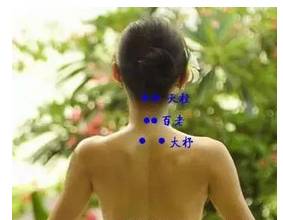 Tianzhu (天柱), Bailao (百劳), and Dazhu (大杼) points.Indications:Cervical spondylosis, neck stiffness.Needling Technique:All three points are needled straight 0.8-1 cun deep. Avoid deep insertion to prevent injury to internal organs. (Same as knee three needles)Back Three Needles
Tianzhu (天柱), Bailao (百劳), and Dazhu (大杼) points.Indications:Cervical spondylosis, neck stiffness.Needling Technique:All three points are needled straight 0.8-1 cun deep. Avoid deep insertion to prevent injury to internal organs. (Same as knee three needles)Back Three Needles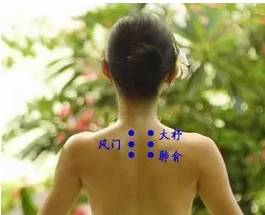 Dazhu, Fengmen (风门), and Feishu (肺俞) points.Indications:Bronchitis, asthma, back pain.Needling Technique:Insert obliquely towards the spine 0.5-0.7 cun. Avoid deep insertion to prevent injury to internal organs.Ankle Three NeedlesJiexi (解溪), Taixi (太溪), and Kunlun (昆仑) points.Indications:Ankle joint swelling, pain, activity restrictions, heel pain.Needling Technique:All are needled straight 0.8-1 cun deep.Atrophy Three NeedlesUpper limb atrophy: Quchi, Hegu, and Chize (尺泽) points. Lower limb atrophy: Zusanli, Sanyinjiao, and Taixi points.Indications:Atrophy syndrome: (muscle weakness, lack of strength, activity restrictions).Needling Technique:All points are needled straight 0.8-1.2 cun, using a tonifying technique, slow insertion and fast withdrawal, with the standard being warmth under the needle. Each session lasts 40 minutes, performing the tonifying technique more than 5 times, and electroacupuncture with continuous wave can also be used, at a moderate intensity that is comfortable for the patient. A course of treatment consists of 30 sessions.Fat Three NeedlesMiddle Jiao (中脘), Da Mai (带脉), and Zusanli points.Indications:Obesity, especially abdominal obesity.Needling Technique:Zusanli is needled straight 1-1.5 cun deep, Da Mai is inserted horizontally towards the navel 3-3.5 cun, and Middle Jiao is inserted horizontally towards Guanyuan (关元) 2-3 cun. After insertion, twist the needle every 5-8 minutes, performing 5-6 twists per treatment, leaving the needle for 30-40 minutes, once a day, for 10 sessions as a course of treatment. Electroacupuncture can also be used.Epilepsy Three NeedlesNeiguan, Shenmai (申脉), and Zhaohai (照海) points.Indications:Epilepsy, foot inversion, foot eversion.Needling Technique:Shenmai and Zhaohai are needled straight 0.5-0.8 cun.Brown Three NeedlesQianliao (颧髎), Taiyang, and Xiaguan points.
Dazhu, Fengmen (风门), and Feishu (肺俞) points.Indications:Bronchitis, asthma, back pain.Needling Technique:Insert obliquely towards the spine 0.5-0.7 cun. Avoid deep insertion to prevent injury to internal organs.Ankle Three NeedlesJiexi (解溪), Taixi (太溪), and Kunlun (昆仑) points.Indications:Ankle joint swelling, pain, activity restrictions, heel pain.Needling Technique:All are needled straight 0.8-1 cun deep.Atrophy Three NeedlesUpper limb atrophy: Quchi, Hegu, and Chize (尺泽) points. Lower limb atrophy: Zusanli, Sanyinjiao, and Taixi points.Indications:Atrophy syndrome: (muscle weakness, lack of strength, activity restrictions).Needling Technique:All points are needled straight 0.8-1.2 cun, using a tonifying technique, slow insertion and fast withdrawal, with the standard being warmth under the needle. Each session lasts 40 minutes, performing the tonifying technique more than 5 times, and electroacupuncture with continuous wave can also be used, at a moderate intensity that is comfortable for the patient. A course of treatment consists of 30 sessions.Fat Three NeedlesMiddle Jiao (中脘), Da Mai (带脉), and Zusanli points.Indications:Obesity, especially abdominal obesity.Needling Technique:Zusanli is needled straight 1-1.5 cun deep, Da Mai is inserted horizontally towards the navel 3-3.5 cun, and Middle Jiao is inserted horizontally towards Guanyuan (关元) 2-3 cun. After insertion, twist the needle every 5-8 minutes, performing 5-6 twists per treatment, leaving the needle for 30-40 minutes, once a day, for 10 sessions as a course of treatment. Electroacupuncture can also be used.Epilepsy Three NeedlesNeiguan, Shenmai (申脉), and Zhaohai (照海) points.Indications:Epilepsy, foot inversion, foot eversion.Needling Technique:Shenmai and Zhaohai are needled straight 0.5-0.8 cun.Brown Three NeedlesQianliao (颧髎), Taiyang, and Xiaguan points.
Previous Issues Review
◆ Napping has 6 major benefits, but it is not suitable for everyone; there are 2 types of people who should avoid napping.
◆ Tossing and turning at night? TCM teaches you how to fall asleep naturally; these 12 methods are worth keeping.
◆ What to do when you catch a cold and have a fever? Have you tried these unique TCM tricks?
◆ What is the essence of insomnia? Old TCM practitioners summarize it in these 6 words.
◆ From the essence of Qi and blood, determine if there is a deficiency of Qi and blood.
